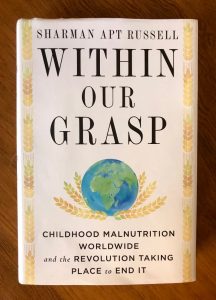The memory is seared into my brain as if made with a red-hot iron: Two women facing each other, standing in the front of an open-air thatched church near the banks of the crocodile-infested Ogooué River in Lastoursville, Gabon, Central Africa, holding a desperately ill baby in their arms.
These African women are conducting a faith-healing ceremony, praying loudly, in tongues, in front of a small congregation of women, all mothers. But the bone-thin, ash-brown baby with a grossly distended belly and grayish-reddish frizzy hair doesn’t react. He is alive, but lifeless. His eyes are open, but dead. He is neither afraid of this dramatic spectacle nor alarmed by it; he has given up.
I know in that moment, as a Peace Corps community health and nutrition volunteer there, that there’s a name for this baby’s woeful condition. It is kwashiorkor, a word from the Ga language meaning “the disease the deposed baby gets when the next one is born.” I know too there is nothing I, nor perhaps anyone in that thatch church, can do to save him. He is too far gone.
That moment, nearly twenty-five years ago, was perhaps the lowest point in my two-year Peace Corps experience, when the hope I’d been striving to foster for Africa was eclipsed by hopelessness. That baby – and countless others like him – would die of malnutrition, I knew.
But that was then. Today, especially after just having read Sharman Apt Russell’s new nonfiction book, Within Our Grasp: Childhood Malnutrition Worldwide and the Revolution Taking Place to End It, I now know there is hope. And I’m tempted to shout this message from my rooftop.
In this, her twelfth published book, award-winning author Sharman Russell, whom I was fortunate enough to have as one of my mentors in graduate school at Antioch University in Los Angeles, offers an uplifting account of what good people are doing to end childhood hunger throughout the world.
Intertwined with solid research and stories of nutrition experts on the front lines of finding ways to end malnutrition for good, Sharman writes of her travels to Malawi, “the warm heart of Africa,” the site of path-breaking, cutting-edge research into childhood malnutrition. Her writing is so vivid and down to earth, we feel we are actually there with her in Malawi. We feel her heartbeat. We sense her hope.
As she has said about this hope: “We now have the knowledge, the means, and the motivation. Ending childhood malnutrition and stunting would have enormous economic and environmental rewards. This is really within our grasp.”
Sharman, clearly, is an optimist. She acknowledges that the problem of childhood malnutrition worldwide has “a lot of moving parts” that have not yet fully fit together. She writes, “…when you factor in ideas of synergy and surprise, then the movement to end childhood stunting has the potential to snowball. That may be optimistic, but it’s not crazy. As one activist said, ‘Nobody will stand against initiatives for children when the solutions are proven and affordable.’ Proven and affordable. We’ve reached this point.”
Sharman is also clearly passionate about the cause — and her place, as a storyteller, in it. Her final words in this important and timely book are:
“The power of a story can change the world. We have seen this happen many times in the sweep of human history and in our own lives. Healthy children require a healthy Earth. The Earth we have become, the Earth that we cover like a new skin, requires healthy children. Our future as a species – our story – requires both. Feeding all our children is about who we are and who we want to be.”
~ ~ ~ ~ ~ ~ ~ ~
To order Sharman’s new book go to: Within Our Grasp: Childhood Malnutrition Worldwide and the Revolution Taking Place to End It
To learn more about Sharman’s many other award-winning books, go to her website: www.sharmanaptrussell.com.
To learn more about my own on-the-ground experience in Gabon as a health and nutrition Peace Corps volunteer, read How to Cook a Crocodile: A Memoir with Recipes https://www.amazon.com/dp/1935925008/ref=cm_sw_r_cp_ep_dp_UPcnBb5KHDE11

